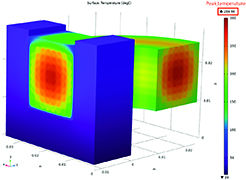Improved Motor Performance and Longevity with Ceramic Insulation
MS student Brain Wolhaupter with Advisor K. Haran
This research is focused on boosting the longevity and performance of high-power density motors by enhancing heat extraction from the stator windings through increasing use of ceramics in the stator. The two largest thermal barriers in the stator are the potting compound (typically an epoxy) and the slot liner (typically Nomex). Both materials have low thermal conductivities. This traps heat in the stator, limits motor performance, and accelerates the insulation’s thermomechanical aging. Improving the thermal conductivities while maintaining sufficient electrical properties of these components by using high-performance ceramics will optimize longevity and performance. Initial thermal simulations done in COMSOL are shown below utilizing a SolidWorks CAD model developed by Anjana Samarakoon. The simulation parameters are identical, except for the insulation material thermal conductivities. In Figure 1, the model uses a conventional motor epoxy and a conventional Nomex slot liner. Note the concentration of high temperatures in the slot, and the hot spot temperature of 284.66⁰C. Figure 2 shows the thermal analysis of the proposed ceramic slot liner and ceramic based potting material. It has a hotspot temperature of 98.69⁰C (a reduction of more than 185⁰C) and a more even thermal distribution throughout the winding. This temperature reduction and distribution reduce the effects of thermal and mechanical degradation and can allow for higher currents through the stator without damaging the insulation. This research is supported by NASA.

